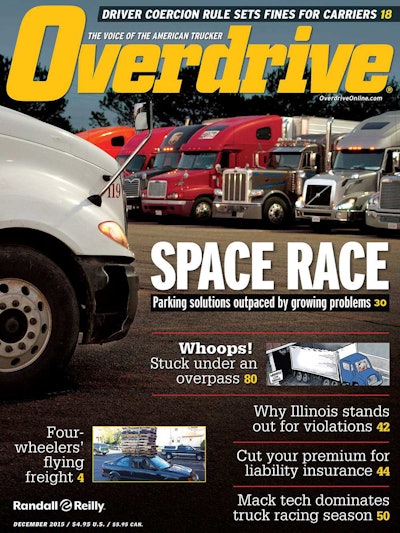Follow this link for the first installment in this year in review, counting down the hours in the duty day, and more, leading into the new year. For the previous, second part, run through the following link.
14, 13, 12, 11, 10, 9, 8, 7, 6, 5 …
 September’s announced Brake Safety Week inspection blitz around the nation was trumped this year in some ways by a national brake-check day, unannounced, in early May.
September’s announced Brake Safety Week inspection blitz around the nation was trumped this year in some ways by a national brake-check day, unannounced, in early May.Four …
A news flash came across the wires — Lumpers at several grocery warehouses offered up gifts as appreciation for drivers during a week in September perennially dedicated to such. The Brake Safety Week inspection blitz came and went without a hiccup but for some attention paid to just what state truck enforcement departments put the most attention on brakes. (Steve didn’t care, he noted — “Gone fishin’…”)
Late reports from the late-August Great American Trucking Show continued to come in from the show’s Pride & Polish floor, including this brief talk with Texas-based reefer owner-operator Freddie Velasco and his “California Dreamin'” 2003 Pete.
[youtube MK2q1F9nehA nolink]
Proposals to boost truck weight limits on the National Highway System above the longstanding 80,000 lbs. to 91,000 with a third trailer axle were floated in Congress and immediately decried by many readers as holding little if any benefits for operators and small fleet owners.
Bedrock issues for owner-operators — parking, detention — reared their heads, in the case of detention attendant to coverage of changing practices around detention pay in the magazine that showed some evidence of compensation for excess waits becoming more of a standard throughout the industry.

Not everyone agreed that was the case, though, and many emphasized a contention that they believed should have held more prominence in the story — detention pay is just a tool toward giving disorganized shippers and receivers incentive to keep the rigs moving, already.
A Georgia-based log truck owner-operator was hijacked near a rural loading site by a killer on the run and shot when he refused to use his truck as a battering ram when surrounded by police.
Three …
The month of October would see continuing heat around previously mentioned bedrock issues, with action from the Federal Motor Carrier Safety Administration and Congress both looming with new rules and the five-year FAST Act highway bill that eventually passed both houses of Congress in early December. As drafters unveiled specific versions of the first longer-term bill to see the light of day in almost a decade, beltway types revealed language that ignored a basic industry reality, illustrating a marked lack of understanding of how the current safety rating program works.
After a full committee mark-up in the House of Representatives in early November, that potential “poison pill” for unrated or Conditional rated independents and small fleets still remained in language of the FAST Act’s House version. A Surly Long Haul Trucker was spotted in Nashville, and the number four was revealed as a new overuse standard for the scare-quoting of “professional” when referring to professional drivers in newspaper letters to the editor from four-wheelers.
 Texas-based independent cattle and hay hauler Zach Beadle’s 1976 Peterbilt cabover was going strong after decades of service. Beadle noted he wouldn’t soon sell the unit, given all the emissions-system issues he was seeing among colleagues’ newer units.
Texas-based independent cattle and hay hauler Zach Beadle’s 1976 Peterbilt cabover was going strong after decades of service. Beadle noted he wouldn’t soon sell the unit, given all the emissions-system issues he was seeing among colleagues’ newer units. The fully restored Evel Knievel Mack cabover combo made a mid-month appearance at a Mack dealer in Missouri, and details of the paint design on the restored unit, mixing layouts from various of Knievel’s famous jumps, were reported.
The fully restored Evel Knievel Mack cabover combo made a mid-month appearance at a Mack dealer in Missouri, and details of the paint design on the restored unit, mixing layouts from various of Knievel’s famous jumps, were reported.A group of owner-operators and drivers brought off its second annual Virtual 5K run to get truckers moving, as two South Carolina-based owner-operators regrouped after historic flooding in the state put a damper on trucking operations throughout its borders. One of them, in turn, the “Carolina Monkey Gouger” Jimmy Ardis, was featured in a serio-comic documentary take on American culture, his rapid-fire CB sign-on a highlight of the “Freedom, the Movie” trailer.
A driver lost his life after mattresses not very well-secured to the top of a four-wheeler came unmoored on the New Jersey Turnpike — the trucker’s evasive action to avoid flattening of a quickly-stopping four-wheeler in the lane ahead rolled his tanker rig. Some readers hailed him a hero. Others wondered at whether truckers’ lives really mattered to the authorities as reports that the driver of the van moving the mattresses had yet to be charged in the accident.
Two …
November started some answers to a curious question — Would you spend your 10-hour break with your truck on a moving train? — sparking a wide-ranging conversation among owner-operators on issues of the hours of service, productivity, pay and regulation. It followed a month in which such issues were front and center in the national conversation with repeated coverage in the Wall Street Journal and other outlets.
ScoopMonkey’s “CSA Score Explainer” tool for carriers was introduced maybe a little too late, just a short time before FMCSA was forced by Congress to pull the scores in question from public view, and driver Chris Dowdy had big 2016 plans for his Truckers for Hope group charitable and outreach organization to St. Jude’s children’s hospital.
Singer-songwriter Lindsay Lawler concluded her third annual national Truck Stop Tour in support of the Truckload Carriers Association’s “Highway Angel” program of driver recognition at the downtown Nashville TA.
At the end of the month, a video shot with the assistance of a drone aircraft showed a stop of the Capitol Christmas tree on its haul toward D.C., and carrier/broker-identity thieves’ sophistication was on the rise in scamming brokers out of fuel-advance money. NIMBY concerns — “Do we need any more trucks in our community?” — scuttled a truck-parking project in Texas.
One …
As was also the case in 2014, several big things came to a head in the final month of the year. The companion piece to FMCSA’s planned electronic-logging-device mandate dropped early on, as did a final version of the highway bill, with some good news for independents as the previously noted “poison pill” for unrated carrier did not make it into the bill.
The double-edged sword of that move was that, absent the preferred version of the measure, CSA scores in the future would likely remain important in carrier vetting procedures at brokers and shippers. In the near term, however, also as a result of the highway bill, CSA scores went behind the curtain, pulled from public view pending a study and subsequent revamp of the program required by Congress.
Just what the “private CSA” world would look like remained an open question, though language in the highway bill allowed for continued FMCSA publication of inspection and violation data as well as so-called “absolute measures,” a phrase typically used to refer to the BASIC numbers on which the CSA percentile “scores” have always been based, fueling concerns that the changes required by Congress could ultimately have unintended consequences.
Following in short order after those developments, as any reader knows, were some muted “celebrations” of FMCSA’s ELD mandate, which would require as soon as December 2017 that most interstate carriers keeping hours of service logs use an electronic logging device instead of a traditional paper logbook — the rule’s ultimate success will depend on the outcome of legal challenges already ongoing, OOIDA noting it intended to fight the rule “with everything we have.”
What few celebrations there were related to that rule resulted from an exemption to it for owners of pre-2000 model year trucks, a small slice of the total trucking community but a significant one when it comes to owner-operators and small fleets. Nearly a third of readers reported ownership of a 1999 or earlier model year, and well more than half of all such trucks are controlled by fleets of 4 or fewer trucks.
“I woke up this morning and it was like Christmas in my Classic XL,” noted Chris Thomas in a post to Overdrive’s Facebook page the morning the ELD mandate’s specifics were announced.
But the celebration certainly wasn’t widespread. Many such situated operators objected to the rule hands-down, as evidenced in a variety of reports and podcasts.
 Widespread parking shortages well-documented around the nation are featured in this month’s magazine and in previously published stories online you can access via OverdriveOnline.com/parking.
Widespread parking shortages well-documented around the nation are featured in this month’s magazine and in previously published stories online you can access via OverdriveOnline.com/parking.December reports on parking issues — one of those “it’s bad all over” problems — and news of another Walmart lot that had joined the “no truck parking” ranks, combined with ELD mandate news, led many back down the road to re-stating of the central problem — the 14-hour rule in the hours of service and the lack of flexibility for drivers to sleep when tired and drive when rested free of stress over a rigid duty day.
An anonymous commenter noted the combination of the 14-hour rule and e-logs the “real issue,” naming it a potentially deadly combination for safety of the highways.
“The motoring public,” the commenter wrote, has “no clue how this law affects their safety” by disincentivizing rest in drivers’ race to beat the clock. The public is “led to believe this law increases their safety. In fact, it does the opposite.”
Zero …
All of which in a particular way puts us back where we started, though another 10 hours will be required to get us back to No. 14, of course. Here’s wishing a happy new year to you, whether you’re on the road or celebrating at home. And: A big tip of the hat for doing what you do to keep the country rolling.
Keep tuned in 2016 …














